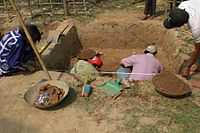Wari-Bateshwar ruins
Part of a series on the |
|---|
| History of Bangladesh |
| Timeline |
|
Classical antiquity
|
|
Mughal Bengal |
|
Pakistan era |
| Bangladesh portal |

The Wari-Bateshwar region (Bengali: উয়ারী-বটেশ্বর Uari-Bôṭeshshor) in Narsingdi, Bangladesh is the site of an ancient fort city dating back to 450 BCE.[1] The 2500-year old ruins being unearthed near the old course of the Brahmaputra River are a major archaeological discovery in South Asia. It challenges the earlier notions of early urban civilization in Bengal.
Geography
The site is about 75 km from Dhaka situated near the Wari and Bateshwar villages in the Belabo Upazila of Narsingdi District.
Discovery

It was discovered in the 1933 by a local school teacher, Hanif Pathan.[1] However, formal excavation started only recently in 2000. The current scientific study is being carried out by a team from the Archaeology Department of Jahangirnagar University led by Professor Sufi Mostafizur Rahman.
History
Prof. Rahman believes that Wari-Bateshwar is the rich, well planned, ancient emporium (a commercial city) "Sounagora" mentioned by Greek geographer, astronomer, mathematician Ptolemy in his book Geographia.[2] The other emporia mentioned in Ptolemy's work include Arikamedu of India, Mantai of Sri Lanka, Kion Thom of Thailand. All of these were the most ancient civilisations in their respective regions, each was a river port, and all of them produced monochrome glass beads. The artifacts found at Wari-Bateshwar bear similarity with those found in the other emporia sites.
Artifacts
According to researchers, the discovery of rouletted ware, knobbed ware, stone beads, sandwiched glass beads, gold-foil glass beads, Indo-Pacific monochrome glass beads and importantly its geographical location indicates to Southeast Asiatic and Roman contacts.[3][4]

Excavation also unearthed the presence of pit-dwelling. The discovery of a pit-dwelling is the first of its kind in Bangladesh. People used to live in these small ditches. The pit-dwelling is a Copper Age or Chalcolithic artifact. Similar pit-dwellings have been found in India and Pakistan which are believed to be 4000 years old. The unearthing of a 180-meter long, six-meter wide and 21–35 cm thick road with a by-lane points to very early urbanisation in this area. Before the discovery of this, the widely held view was that urbanisation occurred later than the Wari-Bateshwar ruins indicate.

Silver punch-marked coins, different types of earthen pots, rouletted ware, knobbed ware, northern black Polish ware, black-slipped ware, common ceramics, semi-precious stone beads. Iron artifacts include blooms, hand-axes, spearheads, knives, nails and slugs, melted pieces of iron. It is also suspected that it might be the oldest place in the world which have a money based currency system.
See also
References
- ↑ 1.0 1.1 MM Hoque and SS Mostafizur Rahman, Wari-Bateshwar, Banglapedia: The National Encyclopedia of Bangladesh, Asiatic Society of Bangladesh, Dhaka, Retrieved: 2012-02-20
- ↑ The Daily Star
- ↑ Excavation At Wari-Bateshwar: A Preliminary Study. Edited by Enamul Haque. Dhaka, The International Centre for Study of Bengal Art, 2001, ISBN 984-8140-02-6
- ↑ Dilip Kumar Chakrabarti, Ancient Bangladesh, Dhaka 1992
External links
- Banglapedia Article on Wari-Bateshwar
- A private album on the excavation (part 1)
- A private album on the excavation (part 2)
- A private album on the excavation (part 3)
- A private album on the excavation (part 4)
- A short video on the excavation.
| ||||||